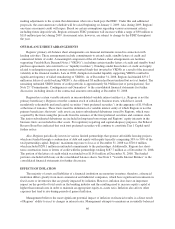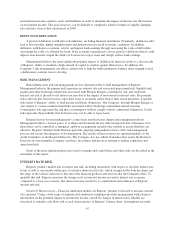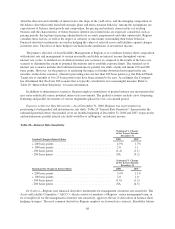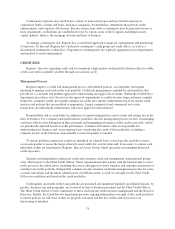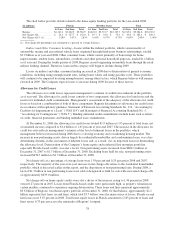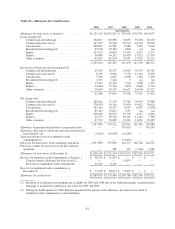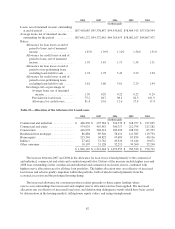Regions Bank 2008 Annual Report Download - page 82
Download and view the complete annual report
Please find page 82 of the 2008 Regions Bank annual report below. You can navigate through the pages in the report by either clicking on the pages listed below, or by using the keyword search tool below to find specific information within the annual report.Reserve Bank through its discount window and/or the TAF program. As of December 31, 2008, Regions had
outstanding through the TAF, $7.0 billion at a rate of 1.39 percent that matured in January 2009 (84 days), $2.0
billion at a rate of 0.60 percent that also matured in January 2009 (28 days), and $1.0 billion at a rate of 0.42
percent that matures at the end of February 2009 (56 days). After the January 2009 TAF borrowings matured,
Regions rebid on TAF funds to maintain excess reserve balances to meet potential liquidity needs. The TAF
borrowings continue to provide the opportunity to carry excess liquidity at very low rates. Future fundings under
commitments to extend credit would increase Regions’ borrowing capacity under these programs.
In October 2008, the FDIC announced its TLGP to strengthen confidence and encourage liquidity in the
banking system by guaranteeing newly issued senior unsecured debt of banks, thrifts, and certain holding
companies, and by providing full coverage of non-interest bearing deposit transaction accounts, regardless of
dollar amount. Regions issued $3.75 billion of qualifying senior debt securities covered by the TLGP in
December 2008, and has remaining capacity under the program to issue up to an additional $4 billion. See
“Long-Term Borrowings”, found earlier in “Management’s Discussion and Analysis of Financial Condition and
Results of Operations”, for additional details.
Morgan Keegan maintains certain lines of credit with unaffiliated banks to manage liquidity in the ordinary
course of business. See Note 13 “Short-Term Borrowings” to the consolidated financial statements for further
details.
If Regions is unable to maintain or renew its financing arrangements, obtain funding in the capital markets
on reasonable terms or experiences a decrease in earnings, it may be required to slow or reduce the growth of the
assets on its balance sheet, which may adversely impact its earnings.
BROKERAGE AND MARKET MAKING ACTIVITY RISK
Morgan Keegan’s business activities, including its securities inventory positions and securities held for
investment, expose it to market risk.
Morgan Keegan trades for its own account in corporate and tax-exempt securities and U.S. Government
agency and government-sponsored securities. Most of these transactions are entered into to facilitate the
execution of customers’ orders to buy or sell these securities. In addition, it trades certain equity securities in
order to “make a market” in these securities. Morgan Keegan’s trading activities require the commitment of
capital. All principal transactions place the subsidiary’s capital at risk. Profits and losses are dependent upon the
skills of employees and market fluctuations. In order to mitigate the risks of carrying inventory and as part of
other normal brokerage activities, Morgan Keegan assumes short positions on securities.
In the normal course of business, Morgan Keegan enters into underwriting and forward and future
commitments. At December 31, 2008, the contract amounts of futures contracts were $494 thousand to purchase
and $60.8 million to sell U.S. Government and municipal securities. Morgan Keegan typically settles its position
by entering into equal but opposite contracts and, as such, the contract amounts do not necessarily represent
future cash requirements. Settlement of the transactions relating to such commitments is not expected to have a
material effect on Regions’ consolidated financial position. Transactions involving future settlement give rise to
market risk, which represents the potential loss that can be caused by a change in the market value of a particular
financial instrument. Regions’ exposure to market risk is determined by a number of factors, including the size,
composition and diversification of positions held, the absolute and relative levels of interest rates, and market
volatility.
Additionally, in the normal course of business, Morgan Keegan enters into transactions for delayed delivery,
to-be-announced securities, which are recorded in trading account assets on the consolidated balance sheets at
fair value. Risks arise from the possible inability of counterparties to meet the terms of their contracts and from
unfavorable changes in interest rates or the market values of the securities underlying the instruments. The credit
72






